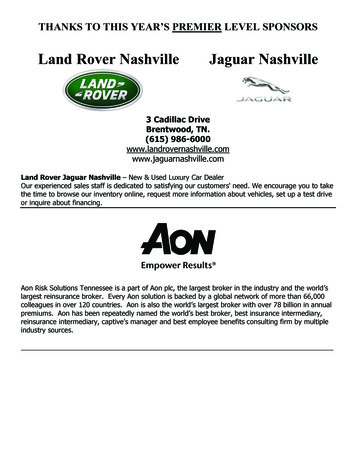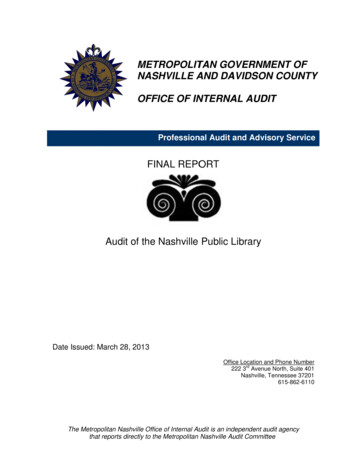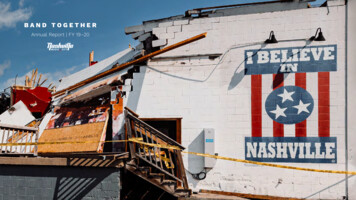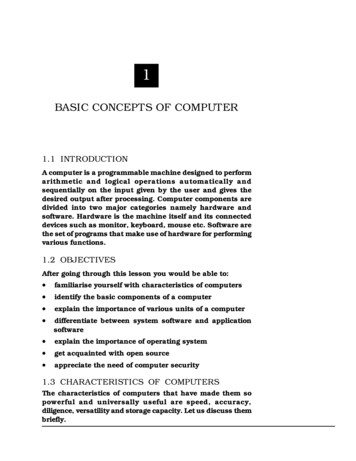
Transcription
12001DrumsetFUNdamentalsDave Black & Mark DorrNASHVILLEN O V E M B E R 1 4 – 1 7 Arranging Your DrumsetOverall SetupThe drums and cymbals should be centralized around the player in such a way as to minimize reaching,stretching and twisting. The drums should be set in such a way as to accommodate the player—not thereverse.
22001DrumsetFUNdamentalsDave Black & Mark DorrNASHVILLEN O V E M B E R 1 4 – 1 7 Throne (Stool) HeightThe position and height of the drum throne is critical to proper balance and directly affects the flexibility andperformance of the feet. Because each person is built differently, throne adjustments are of a personalnature. It is crucial to find a height and distance that will allow total relaxation, specifically of the hips, legs,ankles and upper body. (If you experience pain in your lower back, additional adjustments will need to bemade.)Adjust the throne height so the hip is slightly above the knee when sitting. Draw an imaginary straight linevertically from the front of your knee to the back of your foot. In this position, the ligaments, tendons andmuscles are flexible and free to move naturally, whether you play heel up or heel down. (Stretching exercises will help achieve maximum flexibility.) From this position, make slight height and distance adjustmentsto suit your personal needs. Remember, if you sit too close or too far away from the drumset, your limbs maymove unnaturally, causing undo stress on your joints, ligaments and muscles, which, in turn, will minimizeflexibility when playing. Always set the drums up to you!The Snare DrumWhether played with matched or traditional grip, the snare drum should be positioned and angled so thatthe proper alignment of the forearms and hands is not affected. With matched grip, the snare drum isusually flat or slanted down toward the player; with traditional grip, the snare drum is usually tilted slightlydown toward the right (if right-handed).The Mounted (Rack) TomsDrummers may use one or more mounted toms. They should be slightly tilted toward the player so as toallow him/her to clear the drums’ rims when striking the heads comfortably with the side of the stick tip. (Thestick should almost be parallel to the drumhead.) Avoiding a severe angle with the drumstick will not onlyproduce the best tone, but will also reduce the likelihood of damaging the drumhead.The Floor TomThe floor tom should be approximately the same height as the snare drum. It may be slightly angled towardthe player or toward the snare drum.
32001DrumsetFUNdamentalsDave Black & Mark DorrNASHVILLEN O V E M B E R 1 4 – 1 7 Overall Cymbal SetupIf you are using several cymbals, it is wise to arrange them around yourself in such a way as to minimizereaching, stretching and twisting. In order to obtain the most optimal tonal/playing position, the cymbalsshould be positioned so that your elbow is slightly ahead of your shoulder in order to avoid tension. Theexact placement, of course, will depend on your physical size and technical ability. If a regular cymbalstand does not allow for correct positioning of the cymbals, the use of a boom stand is highly recommended. Remember, proper cymbal positioning will help to assure optimal sound quality and volume whileminimizing any possibilities of damage to the cymbal(s). Again, the drums/cymbals should be set in such away as to accommodate the player—not the reverse.The Ride CymbalThe ride cymbal should be positioned in such a way as to allow the stick to strike 2 to 4 inches in from theedge.The Crash Cymbal(s)Drummers often use one or more crash cymbals so that a cymbal can be matched with a particular instrument sound. Crash cymbals are generally tilted slightly and positioned so that the drumstick’s shaft isallowed to strike the cymbal’s edge at about a 45-degree angle. (Some drummers place their crash cymbals above normal playing height to maximize visual effect.)Extreme angling of a crash cymbal will restrict the cymbal’s movement, diminish its response and putunnecessary pressure on the bell (cup) area. If a greater cymbal angle is desired, a cymbal tilter—oftenalso incorporating a spring to serve as a shock absorber—may prove desirable.The Hi-HatThe hi-hat is placed to the left of (and slightly above) the snare drum, and is operated by the left foot (for aright-handed player). The hi-hat consists of a pair of cymbals mounted one above the other and connectedto a foot pedal. When at rest, the cymbals should be separated by 1 to 2 inches.
42001DrumsetFUNdamentalsDave Black & Mark DorrNASHVILLEN O V E M B E R 1 4 – 1 7 Have You Had Your “Fill” Today?When playing with a band, the drummer is expected to perform a variety of roles, even within a singlechart. While the primary function is to keep time, the drummer is also often called upon to serve in anumber of ways, including the following.Drum FillsFills are used to “fill in” space and usually occur at phrase endings. They are not to be played loudly, as theyare often played along with other instruments.Fills in a rock idiomFills in a jazz idiom
52001DrumsetFUNdamentalsDave Black & Mark DorrNASHVILLEN O V E M B E R 1 4 – 1 7 Solo FillsSolo fills are simply fills played in solo fashion, without any other instruments sounding. They are generallyplayed louder with the purpose of drawing attention to the drummer. Always practice fills in a musical “time”setting; although fills break away from the basic beat, they should not speed up or slow down. As a generalrule:1. One should think of fills as melodic lines.2. Fills can be used as a way to bridge sections of a musical work.3. The volume and complexity of a fill will depend on what happens nextwithin a specific tune.
62001DrumsetFUNdamentalsDave Black & Mark DorrNASHVILLEN O V E M B E R 1 4 – 1 7 Playing Setups for Ensemble FiguresThe drummer is expected to “set up” major ensemble entrances. This concept, idiomatic to jazz alone, callsfor a drummer to play a rhythm that leads up to a major ensemble entrance. It usually ends on the beat justbefore the ensemble figure begins and helps to keep the ensemble’s entrance tight.Within the context of an ensemble “shout chorus”
72001DrumsetFUNdamentalsDave Black & Mark DorrNASHVILLEN O V E M B E R 1 4 – 1 7 SoloingDrummers are frequently called upon to solo within a piece of music. Such solos can be measured (forexample, 4 bars in length) or unmeasured (often called “open,” meaning that the solo’s length is up to thedrummer and/or band leader).An extended discussion on how to play fills/solos goes beyond the scope of this clinic. The best way to geta feel for how to play fills is to listen to recordings of great drummers, attend live performances, play alongwith your private instructor, and to practice in an ensemble setting (including bass, piano, guitar, etc.).There is simply no substitute for a great deal of focused listening and/or playing in order to master theplaying of ensemble figures, solos and fills.
82001DrumsetFUNdamentalsDave Black & Mark DorrNASHVILLEN O V E M B E R 1 4 – 1 7 Suggested Method Books for Private Lesson Study(Beginning to Intermediate Level Drumset)There are many excellent drumset methods available today. Here are a few suggestions to get youstarted:Technical Studies and Sight-reading:Stick Control, George L. StoneProgressive Steps to Syncopation for the Modern Drummer, Ted ReedAccents and Rebounds, George L. StoneModern Reading Text in 4/4, Louis Bellson and Gil BreinesModern School for Snare Drum, Morris GoldenbergModern Rudimental Swing Solos, Charles WilcoxonModern Interpretation of Snare Drum Rudiments, Buddy Rich and Henry AdlerMultiple Musical Styles and Topics:Alfred’s Beginning Drumset Method, Sandy Feldstein & Dave BlackDrum Sessions I-II, Peter O’GormanStudio and Big Band Drumming, Steve HoughtonJazz, Rock, and Latin Sourcebook, Charles DowdMoves and Grooves, Elliot FineThe Ultimate Drumset Reading Anthology, Steve HoughtonChart Reading (exclusively):You’re In The Band, Volume I, Mike EhrhardEssential Styles for the Drummer and Bassist I, Steve Houghton and Tom WarringtonI’ve Got You Under My Skins, Irv CottlerThe Ultimate Drumset Reading Anthology, Steve HoughtonJazz:Alfred’s Beginning Drumset Method, Sandy Feldstein & Dave BlackShuffle Drumming Workbook, Chet DoboeStudio and Big Band Drumming, Steve HoughtonJazz, Rock, and Latin Sourcebook, Charles DowdDrum Solos and Fill-Ins for the Progressive Drummer, Ted Reed
92001DrumsetFUNdamentalsDave Black & Mark DorrNASHVILLEN O V E M B E R Rock, Fusion, Funk, Contemporary:Alfred’s Beginning Drumset Method, Sandy Feldstein & Dave BlackA Funky Primer, Charles DowdRealistic Rock, Carmine AppiceRockin’ Bass Drum, Book II, John Lombardo and Charles PerryThe Encyclopedia of Groove, Bobby RockRock ‘n Roll Drums, Palmer-HughesMonster Book of Rock Drumming, Joel RothmanJazz, Rock, and Latin Sourcebook, Charles DowdAfro-Caribbean, Brazilian, African:Jazz, Rock, and Latin Sourcebook, Charles DowdMoves and Grooves, Elliot FineBrazilian Percussion Manual, Daniel SabanovichGeneral Reference:52nd Street Beat: Profiles of Modern Jazz Drummers 1945-1965, Joe HuntThe Great Jazz Drummers, Ronald Spagnardi / William F. Miller, ed.For the Record: A Collection and Analysis of Transcribed Drum Solos,transcribed by David M. WoodHitmen: Inside Look at the World of the Studio Drummer, Sam BradleyDifferent Drummers, Billy MintzDrum Wisdom, Bob Moses 1 4 – 1 7
102001DrumsetFUNdamentalsDave Black & Mark DorrNASHVILLEN O V E M B E R 1 4 – 1 7 Suggested Method Books for Private Lesson Study(Intermediate to Advanced Level Drumset)There are many excellent drumset methods available today. Here are a few suggestions to get youstarted:Technical Studies and Sight-reading:Accents and Rebounds, George L. StoneMaster Studies, Joe MorelloOdd Time Reading Text, Louis Bellson and Gil BreinesThe Moeller Method, Jim Chapin (ms)Portraits in Rhythm, Anthony CironePatterns: Volume I-Rhythm and Meter Patterns, Gary ChaffeePatterns: Volume II-Sticking Patterns, Gary ChaffeePatterns: Volume III-Time Functioning Patterns, Gary ChaffeePatterns: Volume IV-Technique Patterns, Gary ChaffeeDrumset Etudes, Books I-III, Joe HolmquistDrumset Reading, Ron FinkLinear Drumming, Michael SnyderMultiple Musical Styles and Topics:Musicians Guide to Polyrhythms, Volumes I and II, Peter MagadiniThe New Breed, Gary ChesterStudio and Big Band Drumming, Steve HoughtonDrum Concepts and Techniques, Peter ErskineDouble Bass Drumming, Joe FrancoBass Drum Control, Colin BaileyEven in the Odds, Ralph HumphreyJazz, Rock, and Latin Sourcebook, Charles DowdNew Orleans Drumming, Roy Burns and Joey FarrisMoves and Grooves, Elliot FinePoly-Cymbal Time, Peter MagadiniLinear Drumming: A Creative Approach, Michael Snyder / Charles Dowd, ed.A Drummer’s Digest of Rhythms and Charts, Fred BocchinoEssential Techniques for the Drumset, Ed SophThe Ultimate Drumset Reading Anthology, Steve HoughtonCountry Styles for the Drummer and Bassist, Brian Fullen and Roy VogtAlfred MasterTracks (Blues; Jazz; Fusion; Latin), Steve Houghton and Tom WarringtonNew Orleans Drumming, Roy Burns and Joey Farris
112001DrumsetFUNdamentalsDave Black & Mark DorrNASHVILLEN O V E M B E R Brush Technique:The Sound of Brushes, Ed ThigpenContemporary Brush Techniques, Louie Bellson, Hank Bellson and Dave BlackChart Reading (exclusively):Essential Styles for the Drummer and Bassist II, Steve Houghton and Tom WarringtonDrummers: Masters of Time, Steve DavisStandard Time: Jazz Drums, Steve DavisJazz Drums: Style and Analysis, Steve DavisWipe Out, Jim ChapinDrumset Reading, Ron FinkI’ve Got You Under My Skins, Irv CottlerThe Ultimate Drumset Reading Anthology, Steve HoughtonTheir Time Was The Greatest, Louie BellsonJazz:Advanced Techniques for the Modern Drummer, Volumes I & II, Jim ChapinThe Art of Bop Drumming, John RileyShuffle Drumming Workbook, Chet DoboeJazz Bible of Coordination, Joel RothmanDrum Solos and Fill-Ins for the Progressive Drummer, Ted ReedDrumset Independence and Syncopation, Dave BlackAlfred MasterTracks - Blues, Steve Houghton and Tom WarringtonAlfred MasterTracks - Jazz, Steve Houghton and Tom WarringtonRock, Fusion, Funk, Contemporary:Future Sounds, David GaribaldiAdvanced Funk Studies, Rick LathamThe Drummer’s Cookbook, John PickeringAlfred MasterTracks - Fusion, Steve Houghton and Tom WarringtonA Funky Primer, Charles DowdEncyclopedia of Groove, Bobby RockThe Fusion Drummer, Murray HoullifLinear Drumming, Michael Snyder 1 4 – 1 7 pa
Patterns: Volume II-Sticking Patterns, Gary Chaffee Patterns: Volume III-Time Functioning Patterns, Gary Chaffee Patterns: Volume IV-Technique Patterns, Gary Chaffee Drumset Etudes, Books I-III, Joe Holmquist Drumset Reading, Ron Fink Linear Drumming, Michael Snyder Multiple Musical Styles and Topics: Musicians Guide to Polyrhythms, Volumes I and II, Peter Magadini The New Breed, Gary











